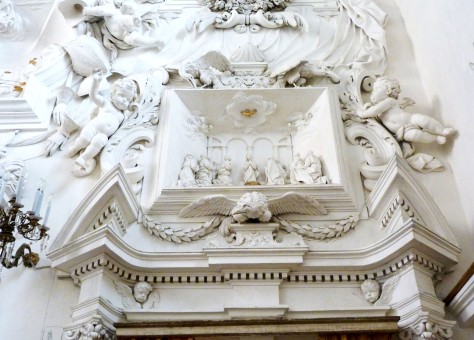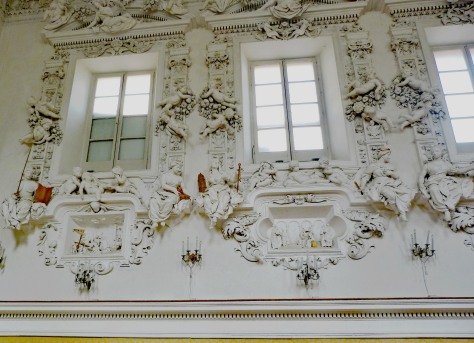Palermo is this year’s Italian City of Culture. The city has stunning architecture, beautiful churches and art that is equal to that in many other parts of Italy, but for me, Palermo’s gem is the baroque Oratory of the Rosario in Santa Cita.

Tucked away in a back street of the capital, this exuberant masterpiece is often overlooked as one stumbles from one opulent Baroque creation to the next in this very theatrical city. The flamboyance is all inside the building, because the Oratory, by its nature, had to be simple. Perhaps that is why it is often missed by visitors to Palermo.

I first saw the Oratorio on the 1912 BBC series Unpacking Sicily, presented by art historian Andrew Graham-Dixon and chef Giorgio Locatelli. As the presenters walked us into a room whose walls were covered with sparkling white putti climbing and curling around pillars, playing with and teasing the allegorical statues I fell in love with the place. It seemed to me to be redolent of joy and happiness as the impossibly round and naked infants cavorted along the walls oblivious to saints or sinners.

Giacomo Serpotta (1652-1732) the Sicilian artist responsible for the interior of the Oratory was a sculptor of genius whose work in stucco* produced a very distinctive style. His work was already sited all over Palermo when he was commissioned in 1699 to transform the Oratorio and according to art historian Anthony Blunt, he was provided with an artistically complex iconographical plan for the oratory.
In his use of stucco, he created a new art form. Sacheverell Sitwell, who considered his female figures to be the equivalent of those in portraits by Gainsborough, states that the sculptor lifted a minor art “out of itself into an eminence of its own”.
![]()
One of three Oratorios (the others being San Dominico and Santa Zita a few metres away) the Oratorio of San Lorenzo is a masterpiece of Sicilian Baroque. The artist worked on this interior between 1698 and 1710, and apart from the cavorting, mischievous cherubs, it features a series of 10 symbolic statues, plus panels detailing the lives of Christ, the lives of St. Francis and St. Lawrence, and one that tells the story of the Battle of Lepanto.
Of extraordinary elegance, white swathes of stucco supported by a swarm of putti flow over the walls; life-size allegorical figures sit casually on ledges as though at a picnic while cherubs play with the draperies of their skirts and blow kisses, and a cornucopia of fruit and flowers adds joy to the scenes.



The Battle of Lepanto is the panel in front of which people stand for a long time absorbing the detail of the battle, the virgin protecting the fleet, the stormy seas, and the two boys sitting on the edge of the panel, one Christian and one infidel, who resemble in every way – even down to their clothes – the street urchins one can still see playing in the streets of Palermo.

The 16th century Battle of Lepanto was the largest naval battle since antiquity and the last major engagement fought between more than 400 rowing vessels. A fleet of the Holy League, a coalition of European Catholic maritime states of which the Venetian and Spanish Empires were the main powers, inflicted a major defeat on the Ottoman Empire in the Gulf of Patras. Miguel de Cervantes, the author of Don Quixote, was one of those injured in the battle.
I think it fair to say that Serpotta displays in this work, an anti-war sentiment, or if not anti-war then a compassion for the enemy unusual at that time.

The altar in the Oratory is disappointing after the sheer gorgeousness of the walls. It was originally famous because it held a masterpiece by the great Caravaggio, a Nativity with St. Francis and St. Lawrence (1609), but this was stolen in 1969. It has never been recovered despite a massive reward being offered. It is presumed that the theft was the work of the Sicilian Mafia and the latest rumour is that it was shredded and fed to pigs.
In 2015 a rather poor digital copy of the altarpiece was placed in the vacant space but it cannot be considered even a good copy.
And now I’ll let the pictures fill in the gaps.
*Stucco: The artist first constructed a model using frames of wood, wire and rags, held together by sand and lime. Over the model a mix of lime and plaster was applied, to which marble dust was added to achieve the smooth surface glaze, This was the invention that lifted Stucco to a higher level and Giacomo Serpotta is credited with creating an original technique that imparted to his work a lustre, not unlike that of stone or marble. Great skill and dexterity were needed as plaster mix dried very quickly but it was valued as it allows the artist not only to build up forms but to carve into them as well.
Address: Via Immacolatella, 90133, Palermo. Tel: 0921 582370


Great job thank for sharing. Really appreciated
LikeLiked by 1 person
Thank you so much for your comment. If it means that others will make the journey to see Serpotta’s stuccoes I’m more than happy. I can’t wait to get back there again and try to get some better pictures, as well as just sitting and enjoying them.
LikeLike
Thank you for your comments and it is especially good to know that even a blog posted 3 years ago is still getting views. I had hoped to get back to Palermo last year but alas, it was not to be, but it is up there in the 1st 3 places I want to visit when we can travel safely again. Thanks again.
LikeLike
Hello! Well informative blog, These things will surely offer a guide on how to improve on fixer upper. It carries a big impact and great ideas. Cool! Keep posting. Thanks!
LikeLiked by 1 person
Thanks for the advice above, but I doubt if I’ll ever attempt anything in stucco. I’m too in awe of the masters to do that!
LikeLike
Next, mix the stucco material along with water to the correct consistency level. Basically, this is something that makes is incredible easy to complete and merely requires following the directions on the trunk of the material. Thus, mix the mandatory levels of water and material to the consistency desired. stucco repair Columbus Oh Finally, make certain that the brand new stucco is blended in well with the prevailing stucco. Using slow and soft strokes with the brand new stucco helps ensure that it’s blended well. It also helps the drying process.
LikeLiked by 1 person
Thanks, Kelly. Wish my photos were better as even the guidebook produced doesn’t do them justice. It’s hard to photograph pure white when the light is coming from all sides and the camera wants to overexpose, but I had hoped the professionals would have done better. I think I may be tempted to buy the video of the Andrew Graham-Dixon visit there.
LikeLike
Great detail
LikeLike
WP is playing up today and this is my 3rd attempt to leave a reply. I Googled the title to make sure I had the correct year and I’ve just done it again, and yes it was first screened in 1912 with a second outing in 1916. I’ve enjoyed all A G-D’s programmes but it’s quite disappointing when you visit some of the places and realize that he had access to them, alone and with professional lighting. And, the close-ups make some frescoes look much bigger than they really are. TV is essential, after all!
LikeLike
Exquisite! (Though fairly sure you did not see it on TV in 1912 😉 )
LikeLike
I remember watching that episode of Sicily Unpacked (I’m watching the current series on Rome too 🙂 ). They’re a likeable pair, aren’t they? I didn’t actually know what stucco was so thanks for explaining that. It’s a phenomenal piece of work.
LikeLike
Yes, very likeable. In their last series though I thought their ‘in-jokes’ got a bit tedious but I’m glad to see a return to their old form. The current series on Rome is brilliant and I am so annoyed with myself for missing nearly all of the stuff they are showing us despite many visits to that city. I’m due there again in mid-March for a few days, so maybe will catch up. A lot depends on the weather, and of course I can’t resist the old favourites.
LikeLike
It’s a city I’ve never been to- always either north or south of there. I’m not sure why it never quite called to me, but maybe someday 🙂 🙂
LikeLike
What fabulous artwork! I don’t think I can recall ever seeing anything quite like this, so I’m especially glad you posted. It’s one thing to be an artist, but it’s probably another to “install” the art, so to speak. Incredible!
LikeLike
My photographs don’t do the Oratorio justice as I only had my compact with me that day. The weight of the better camera got too much after so many days sight-seeing and I had left it back in the hotel and we never got a chance to return to the Oratorio. However, I have since found a clip on YouTube and if you click on Sicily Unpacked; Andrew Graham-Dixon you should be able to see it. It’s well worth it.
LikeLiked by 1 person